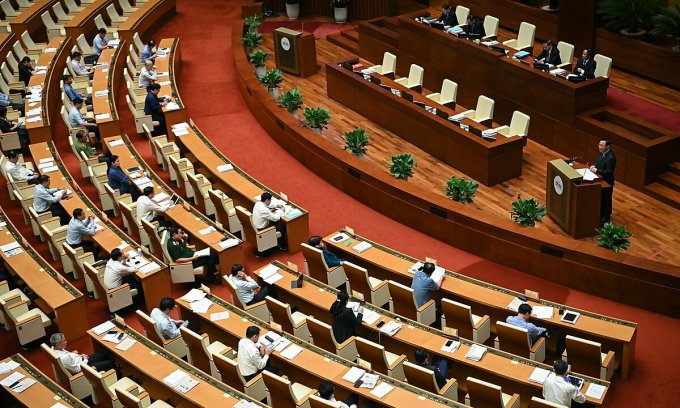Current organizational structure of Vietnamese enterprises

State-owned enterprises are an important subject in the economy, through which the State can partially express its economic policies in certain industries and fields. The Law on Enterprises now has clear regulations on the organizational structure of SOEs. Let’s find out this issue with Lawyer X through the following situation: “Hello, Lawyer! I would like to ask, how much charter capital or more does a state-owned enterprise own by the state? What are the main agencies and departments in state-owned enterprises? Is it the same as the type of enterprise in which state-owned enterprises are created? Thanks for the reply Lawyer!”
Legal grounds
Enterprise Law 2020
What is a state-owned enterprise?
– State-owned enterprises organized and managed in the form of limited liability companies or joint-stock companies, including:
+ Enterprises with 100% charter capital held by the State;
+ Besides, enterprises in which more than 50% of charter capital or total voting shares are held by the State, except for enterprises specified at Point a, Clause 1 of this Article.
– Enterprises in which 100% of charter capital that held by the State as prescribed in Point a Clause 1 Article 88 of the Law on Enterprises include:
+ A one-member limited liability company with 100% charter capital held by the State is the parent company of a state economic group, a parent company of a state corporation, or a parent company in the group of parent companies. – Subsidiaries;
+ One member limited liability company is an independent company with 100% charter capital held by the State.
– Enterprises in which the State holds more than 50% of the charter capital or the total number of voting shares as prescribed at Point b, Clause 1, Article 88 of the Law on Enterprises, include:
+ Limited liability companies with two or more members, joint-stock companies with more than 50% of charter capital held by the State, the total number of voting shares being the parent company of an economic group, the parent company of state corporations, parent companies in the group of parent companies – subsidiaries;
+ Limited liability companies with two or more members, joint-stock companies are independent companies in which more than 50% of charter capital is held by the State and total voting shares.

Applying regulations to state-owned enterprises
– Enterprises in which 100% of charter capital is held by the State under the provisions of Point a, Clause 1, Article 88 of the Law on Enterprises and organized and managed in the form of a one-member limited liability company following this Chapter. and other relevant provisions of the Enterprise Law; In case there is any difference between the provisions of the Enterprise Law, the provisions of this Chapter shall apply.
– Enterprises in which more than 50% of charter capital is held by the State under the provisions of Point b, Clause 1, Article 88 of the Law on Enterprises, which are organized and managed in the form of a limited liability company with two or more members by the provisions of the Law on Enterprises. specified in Section 1 Chapter III or a joint-stock company under the provisions of Chapter V of the Enterprise Law.
Management structure
The owner’s representative agency shall decide to organize the management of a state-owned enterprise in the form of a one-member limited liability company according to one of the following two models:
– President of the company, Director or General Director, Supervisory Board;
– Board of members, Director or General Director, Supervisory Board.
Council members
The Board of members shall, on behalf of the company, perform the rights and obligations of the company per the provisions of the Enterprise Law and other relevant laws.
– The Members’ Council includes the Chairman and other members, the number of which is not more than 07 people. Members of the Members’ Council shall appoint, relieved of duty, dismissed, rewarded, and disciplined by the agency representing the owner.
The term of office of the Chairman and other members of the Members’ Council shall not exceed 5 years. Members of the Members’ Council may be re-appointed. An individual may appoint as a member of the Members’ Council for not more than 02 terms at a company unless he has worked for more than 15 consecutive years at that company before appointing for the first time.
Company president
The company president shall be appointed by the agency representing the owner by the law. The Chairman of the company has a term of not more than 5 years and can be re-appoint. An individual appointed for no more than two terms unless the appointee has had more than 15 years of continuous working at that company before being first appointed. Criteria, conditions, and cases of dismissal and dismissal of the company’s President shall comply with the provisions of Articles 93 and 94 of the Enterprise Law.
– The company president shall exercise the rights and perform the obligations of the direct representative of the owner at the company by the Law on Management and Use of State Capital invested in production and business at the enterprise; other rights, obligations, and responsibilities as prescribed in Articles 92 and 97 of the Enterprise Law.
– The salary, allowance, and remuneration of the President of the company shall be included in the company management expenses.
The president of the company uses the management and administration apparatus and the assisting department of the company to perform his/her rights and obligations. In case of necessity, the company president organizes consultation with domestic and foreign consultants before deciding on important issues within the competence of the company president. The cost consulting experts is specified in the company’s financial management regulations.
Decisions falling within the competence specified in Clause 2, Article 99 of the Law on Enterprises must be made in writing and signed with the title of President of the company, including the case of the President cum Director or General Director.
– The decision of the President of the company takes effect from the date of signing or from the effective date stated in the decision unless it is approved by the agency representing the owner.
– In case the company president leaves Vietnam for more than 30 days, he/she must authorize in writing another person to perform several rights and obligations of the company president; the authorization must be promptly notified in writing to the agency representing the owner. Other cases of authorization shall comply with the provisions of the company’s internal management regulations.
Director, General Director and Deputy Director, Deputy General Director
– The director or general director shall appoint or hired by the Members’ Council or the company’s president according to the personnel plan approved by the owner’s representative agency.
The director or general director is responsible for managing the day-to-day operations of the company and has the following rights and obligations:
+ Organize the implementation and evaluation of the results of the implementation of the company’s plans, business plans, and investment plans;
+ Organize the implementation and evaluate the results of the implementation of resolutions and decisions of the Members’ Council, the company’s president, and the agency representing the company’s owner;
+ Decide on the daily work of the company;
+ To promulgate the internal management regulations of the company which have approved by the Members’ Council or the company’s president;
+ To appoint, hire, relieve from duty, remove from office, and terminate the labor contract of the company’s managers, except for titles under the competence of the Members’ Council or the company’s president;
+ Sign contracts and transactions on behalf of the company, except for cases under the authority of the Chairman of the Members’ Council or the company’s president;
+ Prepare and submit to the Board of members of the President of the company quarterly and annual reports on the results of the implementation of the business plan objectives; financial report;
+ Proposing the allocation and use of profit after tax and other financial obligations of the company;
+ Labor recruitment;
+ Proposing a plan to reorganize the company;
+ Other rights and obligations as prescribed by law and the company’s charter.
– The company has one or several deputy directors or deputy general directors. The number and authority to appoint deputy directors or deputy general directors are specified in the company’s charter. The rights and obligations of the Deputy Director or Deputy General Director are specified in the company’s charter and labor contract.
Supervisory Board, Supervisor
– Based on the size of the company, the agency representing the owner shall decide to establish a Control Board with between 01 and 05 Supervisors, including the Head of the Supervisory Board. The term of Supervisors shall not exceed 05 years and may re-appoint but not exceed 02 consecutive terms at that company. In case the Supervisory Board has only 01 Supervisor, that Supervisor is concurrently the Head of the Control Board and must meet the criteria of the Head of the Control Board.
– An individual may concurrently appoint as Head of the Supervisory Board or Supervisor of no more than 04 state-owned enterprises.
The Head of the Supervisory Board and the Supervisors must have the following criteria and conditions:
+ Possessing a university degree or higher in one of the majors in economics, finance, accounting, auditing, law, business administration, or a major relevant to the enterprise’s business activities and having at least 03 years of working experience; The head of the Supervisory Board must have at least 5 years of working experience;
+ Must not be a company manager and a manager at another enterprise; must not be the Controller of an enterprise that is not a state-owned enterprise; are not employees of the company;
+ Not being a family member of the head or deputy of the head of the agency representing the company’s owner; members of the Members’ Council of the company; Company president; Director or General Director; Deputy Director or Deputy General Director, Chief Accountant; Other controllers of the company;
+ Other standards and conditions specified in the company’s charter.
Related article:
- ORGANIZATIONAL STRUCTURE OF A JOINT-STOCK COMPANY UNDER VIETNAMESE LAW
- SERVICE OF CHANGING THE LEGAL REPRESENTATIVE OF VIETNAMESE ENTERPRISES
Frequently asked questions
State-owned enterprises are organized and managed in the form of limited liability companies or joint-stock companies
The owner’s representative agency shall decide to organize the management of a state-owned enterprise in the form of a one-member limited liability company according to one of the following two models:
– President of the company, Director or General Director, Supervisory Board;
– Board of members, Director or General Director, Supervisory Board.
Enterprises in which more than 50% of charter capital is held by the State under the provisions of Point b, Clause 1, Article 88 of the Law on Enterprises, which are organized and managed in the form of a limited liability company with two or more members under the provisions of this Law. in Section 1 Chapter III or a joint-stock company under the provisions of Chapter V of the Enterprise Law.
Services of Lawyer X.
Prestigious professional services: Firstly, the team of consultants and consultants for many years in the field of civil status, and customer support.
On-time: Certainly, with the motto “Get your lawyer right at your fingertips”, we ensure the service always performs on time. The rights and interests of customers always come first.
Cost: Besides, Lawyer X’s service costs are highly competitive; depending on the nature of the particular case. So, we want our guests to have the best possible service experience. Therefore, costs which guaranteed to be the most suitable and economical for customers.
Confidentiality of client information: Finally, all brand personal information of client Lawyer X will be 100% confidential.
Please contact us immediately with questions about the “Current organizational structure of Vietnamese enterprises”
Contact LSX Lawfirm
Finally, we hope this article is useful for you to answer the question: “Current organizational structure of Vietnamese enterprises”. If you need any further information, please contact LSX Law firm: at +84846175333 or Email: [email protected],
Conclusion: So the above is Current organizational structure of Vietnamese enterprises. Hopefully with this article can help you in life, please always follow and read our good articles on the website: lsxlawfirm.com




